 S&W M-669
S&W M-669
| Length overall | Barrel Length | Weight | Caliber | Action Type | Magazine Capacity |
| 6.875 inches | 3.5 inches | 26oz | 9mm | D.A. auto | 12 (15-30 available) |
The original S&W model 59 was introduced in 1973. I bought one in 1978, when it was still
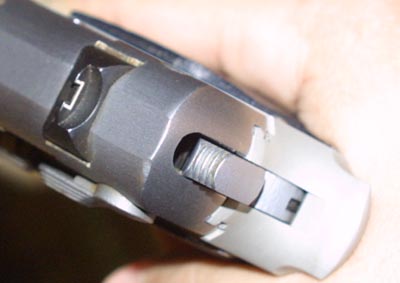 considered a cutting edge weapon. These pistols had double column magazines
which held 15 rounds, a double action trigger, and an alloy frame. This was
heady stuff back in the seventies. On the other hand, these guns had poor
sights, terrible handling qualities, dismal triggers, and a strange anodized
black finish on their new fangled aluminum frames. I needed to sell my M-59,
about seven years after I bought it, and I had not owned a S&W automatic
for years. The Smith auto has come a long way since that first model. The
aesthetics, and ergonomics of the newer guns are considerably improved. The
gun feels much better in the hand, thanks to the three piece, wraparound
grips, and seems to point better. The newer, one piece grips are said to
be even better. The sights are greatly improved over the originals, and are
set atop a flat milled slide. There are some points in common though. I have
a number of old 15 round magazines from my model 59; these function in the
newer gun perfectly, though they stick out of the bottom a bit. The slide
mounted safety is unchanged, decocking the gun when it is applied, and making
"cocked, and locked" carry impossible. This S&W decocker works in the
opposite direction of the Colt safety (down is safe on the Smith). The trigger
pull is smoother than it was on the older gun, but still very familiar, with
the creep that I have come to associate with all double action auto triggers.
considered a cutting edge weapon. These pistols had double column magazines
which held 15 rounds, a double action trigger, and an alloy frame. This was
heady stuff back in the seventies. On the other hand, these guns had poor
sights, terrible handling qualities, dismal triggers, and a strange anodized
black finish on their new fangled aluminum frames. I needed to sell my M-59,
about seven years after I bought it, and I had not owned a S&W automatic
for years. The Smith auto has come a long way since that first model. The
aesthetics, and ergonomics of the newer guns are considerably improved. The
gun feels much better in the hand, thanks to the three piece, wraparound
grips, and seems to point better. The newer, one piece grips are said to
be even better. The sights are greatly improved over the originals, and are
set atop a flat milled slide. There are some points in common though. I have
a number of old 15 round magazines from my model 59; these function in the
newer gun perfectly, though they stick out of the bottom a bit. The slide
mounted safety is unchanged, decocking the gun when it is applied, and making
"cocked, and locked" carry impossible. This S&W decocker works in the
opposite direction of the Colt safety (down is safe on the Smith). The trigger
pull is smoother than it was on the older gun, but still very familiar, with
the creep that I have come to associate with all double action auto triggers.
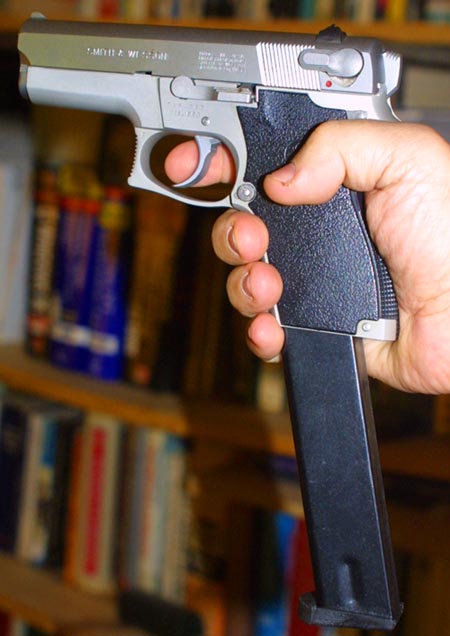 This gun was purchased at a local show, as a companion
to my Marlin Camp Gun. The Marlin is now discontinued, which is a shame.
The Marlin will take the same magazines as the 669 and the rest of the 9mm
Smiths. It will even take the shorter 12 round magazines. In addition
to this, there are now readily available, extended box type magazines which
will hold as many as 30 rounds.
This gun was purchased at a local show, as a companion
to my Marlin Camp Gun. The Marlin is now discontinued, which is a shame.
The Marlin will take the same magazines as the 669 and the rest of the 9mm
Smiths. It will even take the shorter 12 round magazines. In addition
to this, there are now readily available, extended box type magazines which
will hold as many as 30 rounds. The photo to the left shows the 669, loaded with an extended 30 round magazine. The magazine works, and feeds reliably, though it is a bit cumbersome. Actually, this is a pretty silly magazine to use in a pistol. It is a bit more suited to carbine use. These extended magazines are cheap and popular, probably as a reaction to the ten years of the clinton magazine ban. Needless to say, the gun is very awkward to holster, with this magazine in place. Still, if you think that this looks silly, scroll down to the bottom of the page, to see something even sillier.
The M-669 is accurate enough, and I can shoot into about 3" with it at the pistol range. This is not great, but it may be me, rather than the gun, as I am not all that familiar with it yet. This is one of the few stainless guns I have. Though I presently favor my Glocks, and my Para-Ordnance pistols, this gun practically insists on being my household defense gun.
Smith &Wesson had, for a time, fallen into a certain amount of disfavor with many shooters, because of their collusion with the clinton administration's anti gun agenda. This had caused prices to drop on some models, and even set off a boycott. The company has since been sold by it's anti gun British holding company, to a more gun friendly, and enthusiastic American company. My only question is as to why the British company bought S&W in the first place. S&W was sold at a great loss, and the sale probably qualifies as one of the great corporate bargains of the recent past.
The new parent company manufactures gun locks, and is much smaller than it's latest acquisition. This is somewhat reminiscent of a mouse eating a cabbage. Still, the new arrangement seems to be working out well, for both sides. Numerous new models have been introduced, and S&W has recently introduced it's new "X" frame revolver, the first new S&W frame since the introduction of the "L" frame in the seventies. This is also the first frame to eclipse the venerable "N" frame, since it's introduction in the early part of the last century when the big frame was designed. In concert with the introduction of the new frame, S&W has introduced it's first new revolver cartridges since the creation of the .41 Magnum back in 1964. It has also recaptured the title of the most powerful handgun cartridge with the .500 Magnum, and has done so by such a large margin, that it is a title that is unlikely to ever be challenged.
I am pleasantly surprised with the 669. I had initially obtained it because I wanted to mate it to my Camp Gun, and because the price was right, but S&W may have produced a better pistol than I gave them credit for. Like many gun owners, I was very disappointed with S&W, during the clinton years. Like many gun owners, I welcome them back under their new, enthusiastic ownership.
| Disassembling
the S&W |
|
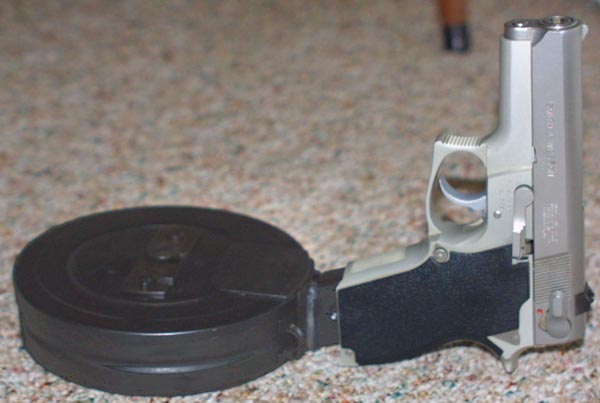
|
The S&W series of semi auto pistols is closely
related in operation and disassembly to the Browning P-35, upon which the
design of it's action is based. The P-35 was, in turn, based pretty closely
upon the design of the M1911 Government model, which was also designed by
Browning. The major design difference is in the use of a cam at the bottom
in the barrel, rather than the pivoting link of the earlier M1911. The newer
design also has the feed ramp integrated with the barrel, as opposed the
two part design of the 1911. |
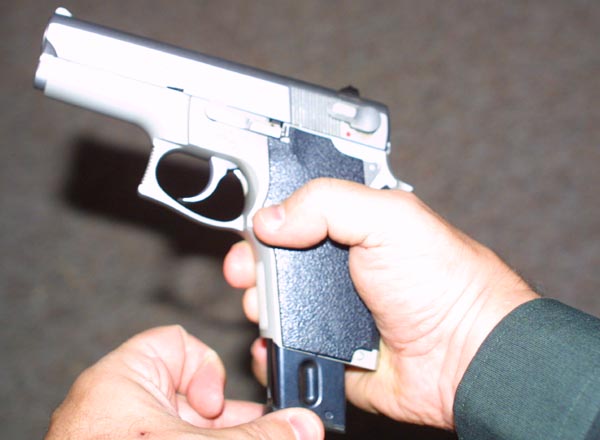
|
As with any semi auto firearm, the magazine should
be released, and the chamber of the weapon should be confirmed as being
empty, before cleaning and disassembly. The S&W series has a magazine
safety, as does the Browning. |
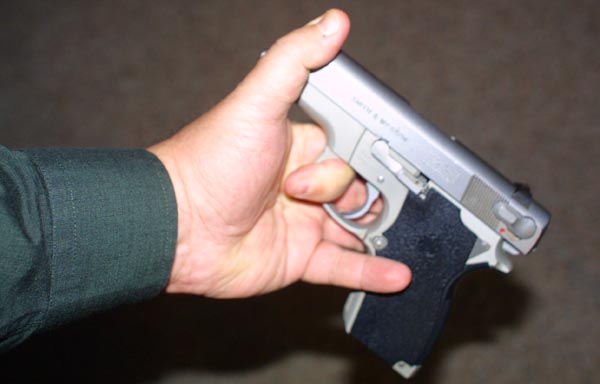
|
The slide of the empty gun, is pushed back part
way, to bring a notch in the slide even with the pivot point of the slide
stop, which doubles as a takedown lever. Removing this lever is the first
step in disassembly. |
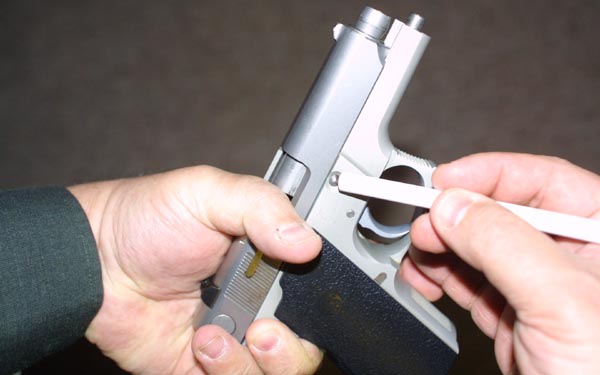
|
On some guns, the takedown lever may be a bit stiff,
and a pen or some other instrument, may be needed to start it on it's way. |
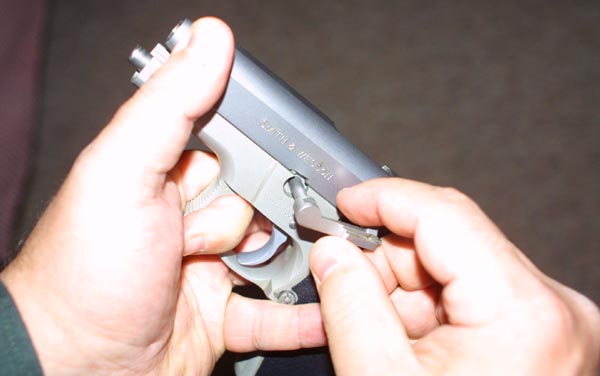
|
The lever is removed, while the slide is held back
to keep the notch properly lined up. |
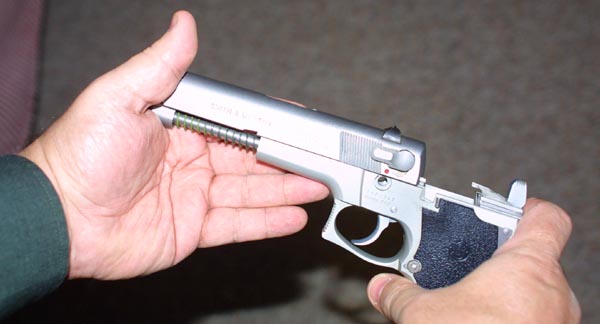
|
With the takedown lever removed, the slide may be
removed by pulling it forward off of the frame. Though the frame may be
brushed, and wiped, and a few drops of lubricant may be placed on the frame
rails, the slide assembly requires the most attention. |
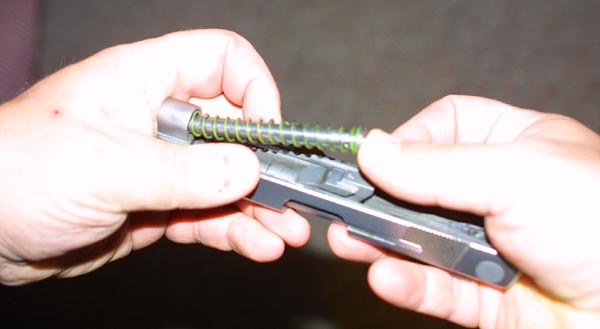
|
With the slide off of the frame, the recoil spring
is easily removed. |
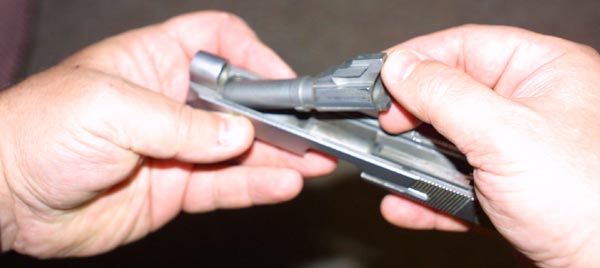
|
The barrel can then be removed for cleaning, and
light lubrication. |
|
The Suomi Drum magazine
|
|
| I have
modified a couple of Suomi magazines to work with this pistol, and with
it's companion Marlin Camp Gun. These drums hold 72 rounds of 9mm ammunition,
and were designed for W.W.II era sub machine-guns. A 72 round handgun, with
the bulky magazine sitting underneath, is pretty silly, even when compared
to the overly long extended magazine which holds a mere 30 rounds; but it
does hold a certain appeal. I deal with the Suomi magazines, and with the
many possibilities they offer, on another page. This magazine was modified
by opening up the feed lips, and welding a standard S&W magazine to the
top as a feeder column. I also needed to convert the top portion for single
feed, and latter on added a feed arm to push all of the cartridges out of
the magazine. The whole thing only took a couple of hours of my time, and
cost well under $100, including the cost of the Suomi drum. I have had no
problems with this magazine, and it has always fed reliably. Still, this
is more of a curio and a toy, than a practical addition. The weight, and
cumbersome aspect of the magazine prevent it from being used very often.
It is certainly nothing I would use for self defense. How could it be holstered? |
|
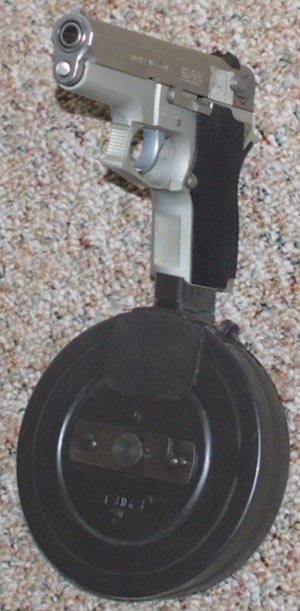
|
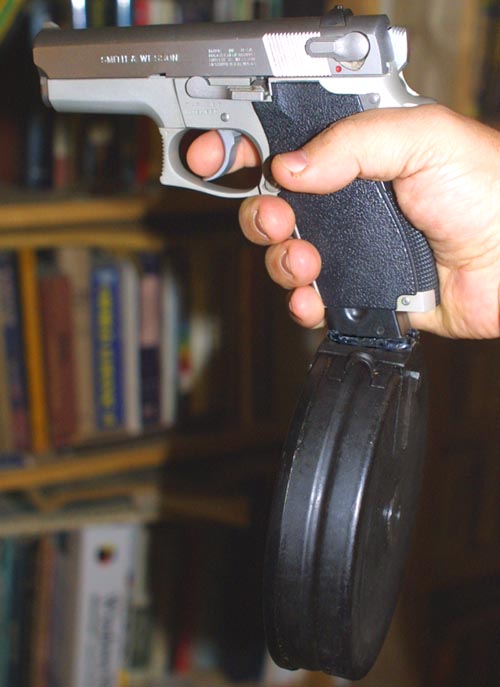
|